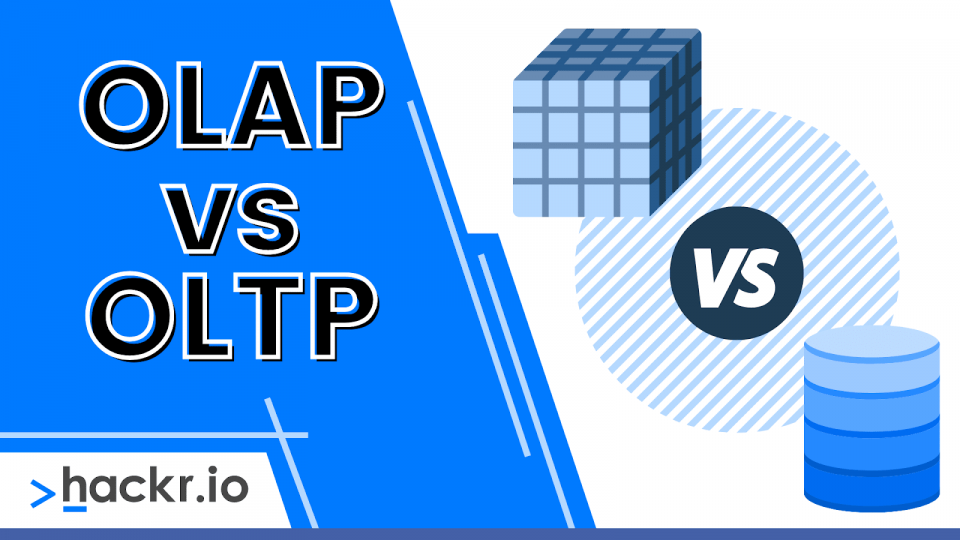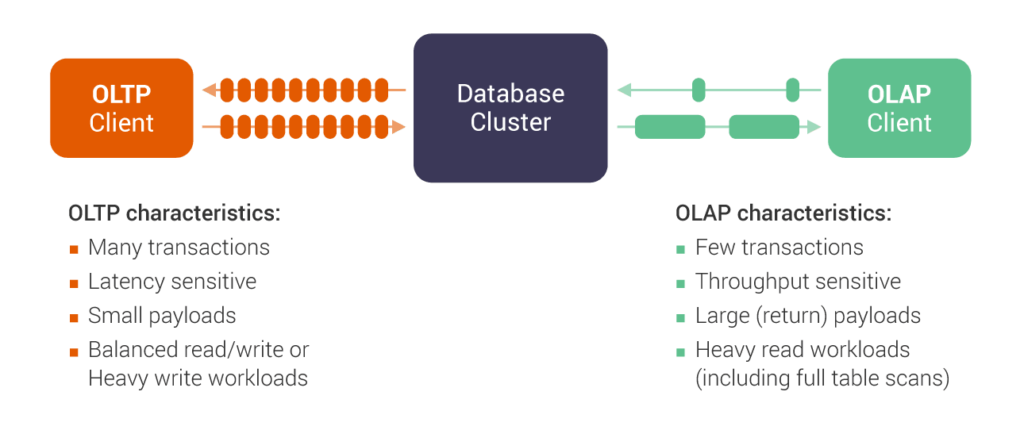
Which is better OLAP or OLTP? OLAP and OLTP are an online processing system. Contrary to a batch system, where transaction details are piled up in a pile of documents and then registered in bulk, an online processing system is a system that registers ongoing transactions in real-time.
OLTP is a transaction processing system, namely; It manages transaction-based applications over the Internet. For example, an OLTP system is responsible for providing data to a data warehouse.
On the other hand, OLAP is an analytical processing system. This simply means that it responds to multi-dimensional analytical queries that correspond to financial reports, forecasts, and so on. For example, the data available to the data warehouse is analyzed using an OLAP system.
A brief introduction to the differences between OLAP and OLTP: One of the main differences between OLAP and OLTP is that the former is an online database modification system, while the latter is an online database query response system. However, the differences between the two online processing systems go far beyond that.
What is the difference between OLAP and OLTP? Before comparing the two online processing systems, namely OLAP and OLTP, let’s get a better understanding of them by defining them in detail and using their respective advantages and disadvantages.
What is an OLTP (Online Transaction Processing) system?
OLTP stands for Online T ransaction P rocessing. The OLTP system becomes the data source for the OLAP system. The primary purpose of a typical OLTP system is to record current update, insert, and delete requests and modify existing databases accordingly.
OLTP systems support transaction-oriented applications in a three-tier architecture. They manage the day-to-day affairs of the organization. Data processing is the primary goal of an OLTP system.
Unlike OLAP databases, typical OLTP databases are updated frequently. OLTP transactions can fail before they complete, causing serious data integrity issues for OLTP systems. Therefore, such an online processing system needs to pay special attention to data integrity.
OLTP systems maintain data integrity in a multi-access environment, and their effectiveness is typically assessed by the total number of transactions they can perform in a single second.
A typical OLTP database stores detailed, current data. The entity model is the schema used to store such transactional databases. As a result, the database on the OLTP system is normalized. Typically, it is implemented using 3NF normalization.
Most OLTP queries are simple and short. As a result, they have less processing time and storage space requirements. ATM is the best example of an OLTP system. Other notable examples of OLTP systems include online banking and sending SMS.
Merit:
- Powerful management of day-to-day transactions
- Streamline individual processes, allowing organizations to grow their consumer base
Shortcoming:
- Allowing multiple users to access and modify the same data causes problems
- Online trading is subject to hardware failures.
What is an OLAP (On-Line Analytical Processing) system?
OLAP is an abbreviation for Online Analytical Processing. The OLAP database stores past data that has been entered using the OLTP system. The OLAP system allows users to view various summaries about stored multidimensional data.
The OLAP system allows information to be extracted from a larger database and analyzed according to the purpose of the decision. To do this, the system provides support for both simple and complex queries.
The effectiveness of an OLAP system is measured by its response time, and its primary goal is data analysis. OLTP systems don’t care much about data integrity. If the transaction fails, the user can simply re-run the transaction and extract the required details.
Compared to OLTP systems, fewer transactions are made using OLAP systems. However, OLAP transactions are long, so they require more processing time and storage space. Tables in the OLAP database may not be normalized.
OLAP databases have aggregated and historical data stored in a multidimensional schema. Typically, this is a star schema.
Examples of OLAP transactions include viewing financial and sales reports, extracting budget information, and viewing marketing management details. A personalized Amazon homepage with product recommendations is also an example of the OLAP system.
Merit:
- Ability to easily impose security restrictions on users to comply with regulations and protect sensitive data
- Consistency of information and calculations
- Provides a single platform for almost all types of business analytics needs
Shortcoming:
- Rely heavily on an IT professional or team for implementation and maintenance
- Effectiveness depends on the collaboration of people across departments.
Comparison of OLAP and OLTP
To simplify the comparison of OLAP and OLTP online processing systems, we have divided the entire section into several categories:

1. Backup & Restore
What is the difference between OLAP and OLTP? OLAP systems require fewer backups. So, in this case, a strict backup plan is not that important. Additionally, some environments may consider reloading the relevant OLTP data as a recovery method instead of regular backups.
From the perspective of an OLTP system, the view of backup and recovery is diametrically opposed to that of an OLAP system. A full backup must be taken at all times, and some sort of incremental backup must be provided.
This is because operational data is critical to business operations, and the loss of such data can lead to undesirable financial and legal problems for the organizations involved.
2. Data
Which is better OLAP or OLTP? Online transactional data is the primary source of data for OLTP systems. Multiple databases on multiple OLTP systems are clustered together to serve as the primary data source for the OLAP system.
The data of the OLTP system is operational data, and the data of the OLAP system is the integration data. The purpose of OLTP system data is to control and run essential business tasks.
For OLAP systems, data is designed to assist in planning, problem solving, and decision-making. Typically, the data exposed to OLTP requests takes the form of screens or screenshots. Instead, the data displayed by the OLAP system is in the form of a multidimensional view.
3. Databases
An OLTP system is an online database modification system that relies on a traditional database management system. The OLAP system utilizes the concept of a data warehouse and is an online database query management system.
While an OLTP database consists of multiple tables, a typical OLAP database has fewer tables. Normalization is optional for tables in an OLAP database (typically using star and/or snowflake patterns).
However, this is not the same as a table that belongs to an OLTP database. In this case, the form must be standardized, usually in 3NF.
4. Data Integrity
OLTP systems often perform transactions that modify databases. In the event of any transaction failure, it can lead to some serious data integrity consequences. As a result, OLTP systems cannot afford to ignore data integrity.
Unlike OLTP systems, OLAP systems experience infrequent transactions. As a result, the likelihood of some transactions failing is very low. As a result, data integrity is not necessarily required for OLAP systems.
5. Primary Intent
OLAP vs. OLTP Differences: OLTP systems focus on inserting, updating, and sometimes deleting information from the database. Instead, the main focus of a typical OLAP system is to allow users to retrieve/extract multi-dimensional data that can be analyzed and used for decision-making.
While users make short and quick inserts and updates to the OLTP system, the OLAP system is characterized by regular long-running batch jobs and select operations to refresh data.
6. Storage Space Requirements
OLTP systems have minimal storage requirements, and even less for those systems that have archived historical data.
On the contrary, OLAP systems require a lot of storage space. This is due to the presence of aggregate structures and historical data, which requires much more indexes than a typical OLTP system.
7. System Type
OLAP is an online data retrieval and analysis system, and OLTP is an online transaction system. Unlike OLAP systems, OLTP systems are responsible for managing database modifications.
8. Transactions
Which is better OLAP or OLTP? The average transaction of an OLTP system is short, so it is fast. However, this is not the case for OLAP systems, where typical transactions last much longer. However, OLAP systems have a lower transaction frequency, whereas OLTP systems have a higher transaction frequency.
The total processing time required for OLTP transactions is small. Conversely, OLAP transactions take a lot of time to execute a single transaction.
This is evident from the fact that the response time of OLTP and OLAP systems is measured in milliseconds and seconds or minutes, respectively.
9. Query complexity
Both OLAP and OLTP systems are query-based. However, queries about OLTP systems are simple compared to OLAP systems that provide support for complex queries.
A typical OLTP query is relatively standardized and returns a few records. OLAP queries, on the other hand, involve aggregating and returning a large number of records or information.
What is the difference between OLAP and OLTP?
| parameter | OLAP | OLTP |
| Backup and restore | OLAP systems require fewer backups. | From the perspective of an OLTP system, backup and recovery are diametrically opposed. A full backup as well as some sort of incremental backup must be taken at all times. |
| data | It utilizes the concept of a data warehouse and is an online database query management system. | Rely on traditional database management systems. |
| Data Integrity | OLAP systems experience infrequent transactions. As a result, data integrity is not necessarily required for OLAP systems. | When it comes to OLTP systems, data integrity cannot be overlooked, as OLTP systems often perform transactions that modify databases. |
| Primary Intent | The OLAP system allows users to retrieve/extract multi-dimensional data that can be analyzed and used for decision-making. | The OLTP system focuses on inserting, updating, and sometimes deleting information from the database |
| Storage space requirements | Due to the presence of aggregate structures and historical data, OLAP systems require a lot of storage space. | It requires less storage space, and for those systems with archived historical data, it requires less space. |
| System type | OLAP is an online data retrieval and analysis system. | OLTP is an online trading system. |
| trade | Transactions are longer, but more frequent. | Short and fast, but less frequent. |
| Query complexity | Complex queries | Simple query |
| spectator | Customer-oriented | Market-oriented |
| table | The table is not normalized | The table is normalized |
| Response time | In seconds to minutes | In milliseconds |
Which is better, OLAP or OLTP
The differences between OLAP and OLTP are summarized
Since OLAP and OLTP in-line processing systems serve different purposes, the choice between them is entirely dependent on needs.
This is the complete difference between OLTP and OLAP. While OLTP systems are good for managing day-to-day tasks, OLAP systems are very good at storing historical data that can be used later for decision-making and problem-solving.